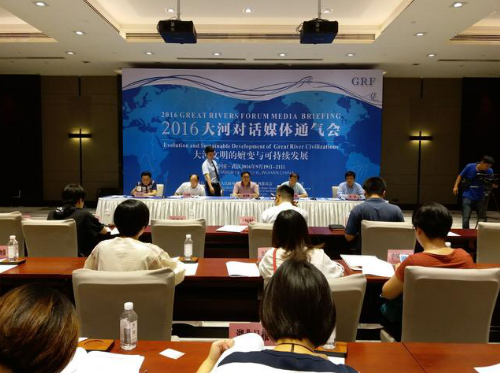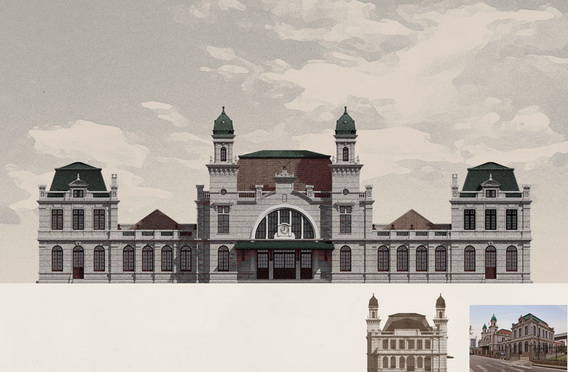Current position: > ENGLISH > COD Application Verification > Part10 >
[10.4]2016 Great Rivers Forum
Release time:2017-09-10 10:58
   Build a Dialogue Platform and Construct a Communication Bridge Wuhan Contributes to Great River Civilization Mayor of Wuhan City Wan Yong Rivers are the lifeblood of the earth and the cradle of human civilization. Looking back to human history, the Nile River gave birth to Egyptian civilization, the Tigris River and Euphrates River bred Mesopotamian civilization, the Indus River and Ganges River shaped Indian civilization, the Yangtze River and Yellow River are the source of Chinese civilization, and the Rhine River, Danube River, Volga River, Amazon River, and Mississippi River provided basis for great river civilization. Human civilization is born and nourished by rivers, and grow and coexist with rivers. The Yangtze River is the longest river in China and the third longest river in the world. It is the mother river of China and gave birth to the colorful Yangtze River civilization. The Yangtze River economic belt strategy in progress vitalizes the ancient Yangtze River civilization. Wuhan is a megacity along the middle reaches of Yangtze River and a cradle of Yangtze River civilization. The remain of Panlong City, the root of Wuhan City, has a history of more than 3,500 years, and honored as source of bronze civilization in the Yangtze River Basin. More than 2,000 years ago, Patriotic Poet Qu Yuan travels eastwards along the Yangtze River and recited poems along the riverside. In the early 17th century, the tea road of ten thousand li, starting from Hankou, the eastern tea harbor, traversed the Eurasia, and became the century artery connecting the Yangtze River to the Volga River. Wuhan is the junction point of the Han River and Yangze River, has the geographical location of the thoroughfare of nine provinces, and showed the commercial prosperity of ten thousands of sailboats and twinkling lamps and candles of myriad families. Wuhan also has the first Yangtze River Bridge, and it is the shipping center in the middle reach of Yangtze River. All of these reflect the profound deposits of Yangtze River civilization of Wuhan. In order to better inherit Yangtze River civilization, Wuhan Municipal People’s Government, Changjiang Water Resources Commission, and Wuhan University jointly built the first great river civilization museum in China, Yangtze River Civilization Museum, and launched the Great Rivers Forum. The purpose is to build a dialogue platform for the great river civilization in the world and construct a bridge for culture communication between the east and the west. This forum is themed with Evolution and Sustainable Development of Great River Civilizations. The guests and experts shared their wise opinions and contributed their efforts to the development of great river civilization, which will facilitate the joint development of the cities in the great river basins.
Based on this forum, we will gather global wisdom, cooperate with the cities in the Yangtze River Basin, and focus on environmental protection, in order to build an ecological, cultural, and economic Yangtze River, and contribute to inheriting Yangtze River civilization and promoting great river culture. Set a Good Example and Face New Challenges Play the New Role of Future Great river Civilization Project Leader of UNESCO World Heritage Convention Michael Turner The river rush down from the holy mountain in the myth, extends hundreds even thousands of kilometers, wanders through mountains and valleys, and runs into the sea. Human beings are constantly evolving and multiplying in such a natural and water environment, and their footprints spread from Africa to the banks of great rivers. The study of Stephen Oppenheimer in Out of Eden enables people to give an insight into the development of human beings and river civilizations throughout the world. Rivers are the source of great river civilizations, such as the Tigris River, Euphrates River, Nile River, Yangtze River, Yellow River, Indus River, Volga River, and Danube River. All of them are the cradle of civilizations and bring language, writing, literature, art, and science. The literatures and data conserved in AmarnaLibrary, Mali Library, Abella Library, Ashurbanipal Library, and Anyang Library show how rivers influence humancivilization. Great rivercivilization plays a leading role in the evolutionary process of cities. No matter whether cities rise or decline, civilization develops sustainably. In the 21st century, human beings will face a lot of challenges. How should we play the new role of great river civilization? We should make efforts as follows: use Internet to describe the great achievements of human beings, and gather power to maintain the value of great river civilization; support each other to control floods and droughts; encourage study on great river civilization; blend cultural heritages of great rivers in people’s daily life; widely mix culture and nature; facilitate the improvement of urban safety, inclusivity, sustainability, and flexibility, and set an example for other tributaries.
China should keep traditional culture alive and fresh. We should share experience and pay attention to the risks and opportunities of human settlement in great river basins. Respect Diversity and Enhance Inclusivity Say No to Vandalism Vice Chairman of International Council of Museums Alberto Garlandini Encourage international cooperation and improve cross-culture relationships for globalizations, encourage more people to get moving, and say no to the acts of destroying cultural heritages and cultural diversity. In many regions, cultural diversity is disrespected. Therefore, museums and cultural heritages are facing more and more threats. Since 2011, cultural heritages (including museums) have been not only the indirectvictims of conflicts but also the target of deliberate sabotage. UNESCO and the International Council of Museums are facing the challenge that cultural heritages and museums are damaged due to political unrest and conflicts. Nowadays, the people having different lineages, cultures, languages, religions and customs live together. How should our community cope with the opportunities and risks brought by globalization? Can fusion, openness, and tolerance overcome narrow nationalism and conflicts? In this globalized world, social integration and cultural interaction become increasingly important, and many traditional identities disappear. An inclusive community should accept and integrate diversified historical origins and identities. The core function of a museum is to conserve and promote collections. However, with social development, museums have new missions and responsibilities. Two months ago, themed with Museums and Cultural Landscapes, the 24th ICOM General Conference was held in Milan, Italy, and adopted a resolution that museums will undertake the responsibility of landscapes. In our opinion, from the perspective of legislation and operability, museums should assume new missions, and buildings and cultural landscapes should be managed as extended museums. Cultural landscapes need to be protected and passed down to the next generation rather than being questioned or modified.
Link:http://news.xinhuanet.com/politics/2016-10/14/c_129321606.htm |
That may be of interest to the article
- Ruopu CITY1000 Creative Projects
- Wuhan Design Biennale
- Wuhan Fashion Week 2018
- Great Rivers Forum
- Engineering Survey and Design Institute Dir
- Wuhan Night held in Beijing Design Week
- Message from Ms Irina Bokova on the Interna
- China's Dinosaur Egg Museum Blends the Anci
- Wuhan: Construct "Five Cultural Cities"
- 2016 Work Report of Wuhan Municipal Governm
- Regulations of Wuhan Municipality on Protec
- The WeChat Official Account of Wuhan Planni
- Wuhan Sets Up a Cultural Enterprise Credit
- Wuhan’s New 30 Articles Provides that At
- Wuhan Industrial Design Development Fund Pr
- Report on the Work of the Government and Po

